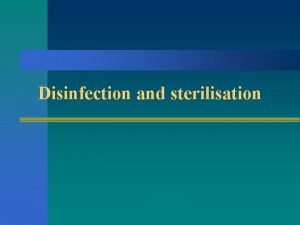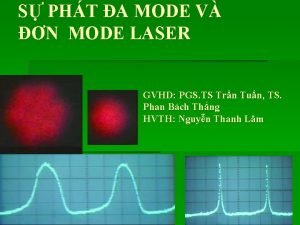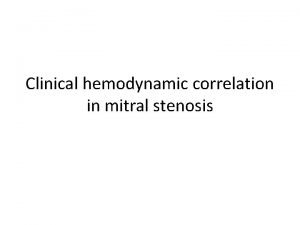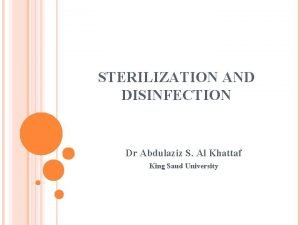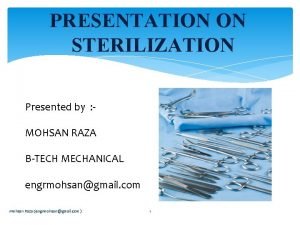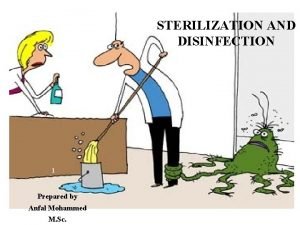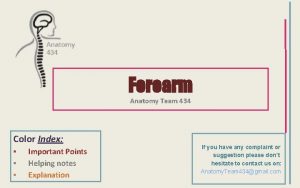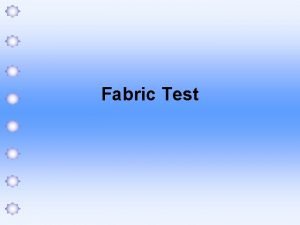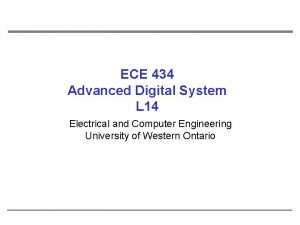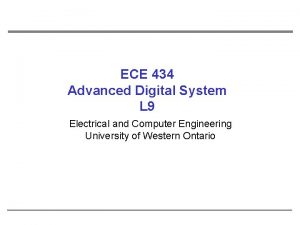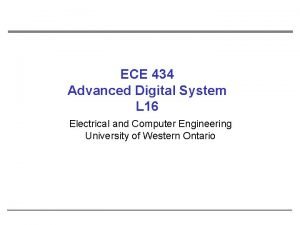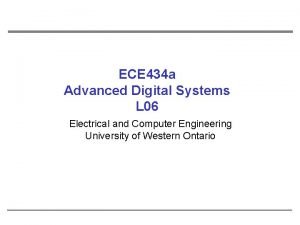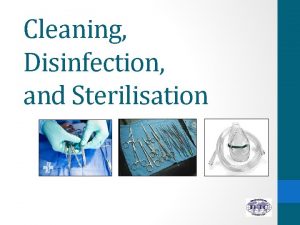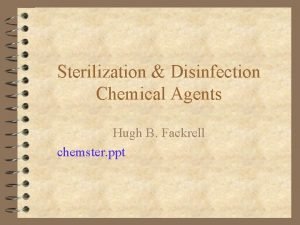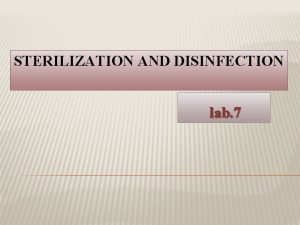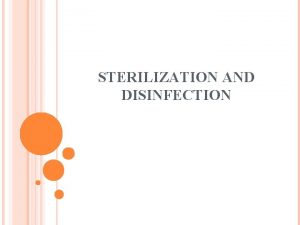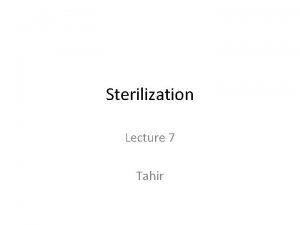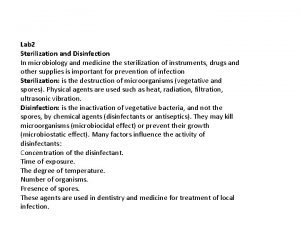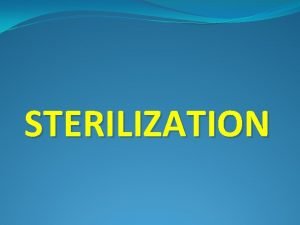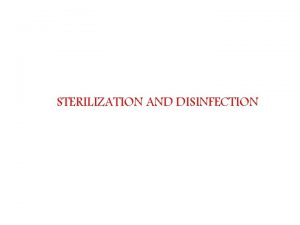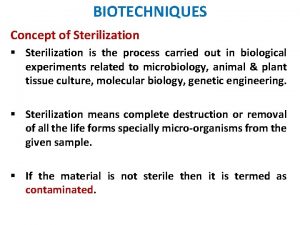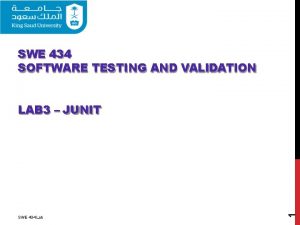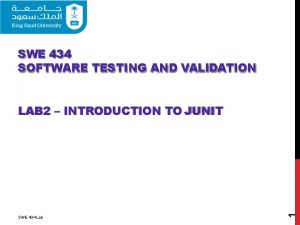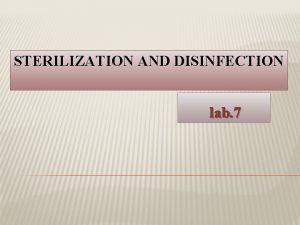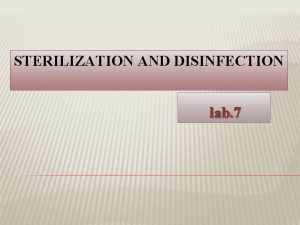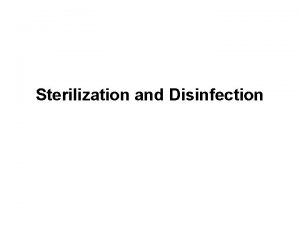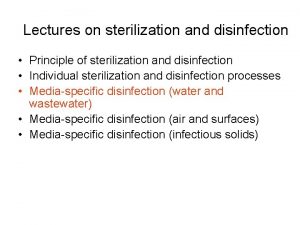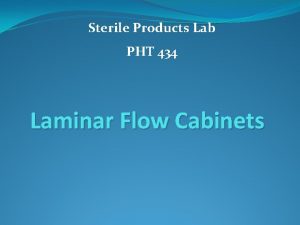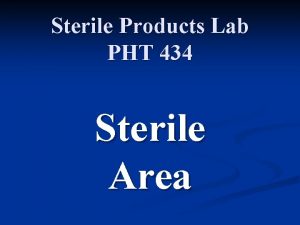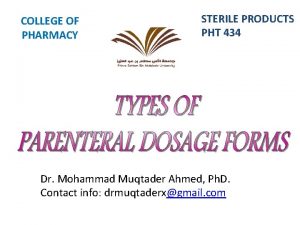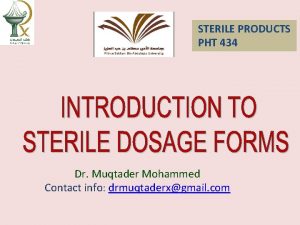Sterilization methods and equipment PHT 434 Sterilization concept



































- Slides: 35

Sterilization methods and equipment PHT 434

Sterilization concept • Sterilization is essential concept in the preparation of sterile products. pharmaceutical • Its aim is to provide a product that is safe and eliminates the possibility of introducing

Sterilization –a process that by which all viable M. O are removed or destroyed , based on a probability function.

Method of inactivating M. O may be classified as either : 1. Physical A. moist heat b. dry heat c. irradiation but it only removes , not inactivates M. O

Method of inactivating M. O may be classified as either : 2. Chemical a. Gaseous b. Liquid sterilants

Sterilization methods

Method Equipment Thermal Moist heat sterilization • Saturated steam autoclaves • Superheated water autoclaves • Air over steam autoclaves • Batch sterilizers • Continuous tunnel sterilizers Non- thermal Chemical cold sterilization • Ethylene oxide • Vaporized hydrogen peroxide • Hydrogen peroxide/steam • Other gases Radiation sterilization • Electromagnetic • Particulate Filtration Membranes Dry heat sterilization

Thermal sterilization �Involves the use of either moist or dry heat. �Moist –heat sterilization is the most widely used and reliable sterilization method. �Dry – heat sterilization is appropriate for materials that cannot withstand moist – heat sterilization

1 -Moist –heat sterilization �Microorganism are destroyed by cellular protein coagulation. �The objects to be sterilized are exposed to saturated steam under 1 atmosphere pressure at a minimum temperature of 121°C for at least 20 -60 minutes. �An autoclave is commonly used for moist – heat sterilization. �Because it does not require as high a temperature, moist – heat sterilization cause less product and equipment damage compared to dry – heat sterilization.

Autoclaves Is a device to sterilize equipment and supplies by subjecting them to high pressure saturated steam at 121 °C or more, typically for 15 -20 minutes

Autoclaves types �Portable autoclave (bench autoclave) �Stationary autoclave (large steriliser) �For porous loads e. g. , dressing �For bottled fluids

Portable autoclave (bench autoclave)

Stationary autoclave (large sterilizer)

Main features of autoclave ( * ) 1. Lid(door) fitted with clamps and asbestos jacket , stationary autoclave may be double doors at both ends one for loading and one for unloading. 2. Pressure gauge 3. Thermocouple for measurement of temp. usually located within the discharge channel in dummy article.

Main features of autoclave 5. Safety valve to permit escape of excess steam to prevent explosion. 6. Modern autoclaves are recording (record pressure, temp during the whole process ) supplied with timer and are automatically controlled.

Advantage of jacket autoclave 1. Rapid in operation as steam is stored in the jacket. 2. More economic as steam is trapped in the jacket and not allowed to escape into the atmosphere. 3. Load comes out dry as the inner surface is always warm.

Operation of the autoclave 1. Articles to be sterilized are placed in baskets or cylinders. 2. Door is closed and clamped 3. Heating is started and steam is generated 4. Air vent is closed after complete removal of air (noticed by continues and vigorous flow of steam from the air vent. 5. When pressure reached that required 1 atm , 121 C , sterilization period is timed.

Operation of the autoclave 6. At the end of the period , heat is disconnected. 7. Autoclave should be not opened before pressure is fallen down.

Air must be removed from autoclave �Because : 1. It reduces the penetration of steam especially with decreasing. 2. It cause superheating in stationary autoclaves. 3. In temp. controlled autoclaves explosion may occur.

2 -Dry – heat sterilization �Is appropriate for materials that cannot withstand moist – heat sterilization (e. g. , oily materials and powders) . �Objects are subjected to a temperature of at least 160 °C for 120 minutes ( if higher temperatures can be used , less exposure time is required).

Non- Thermal method

Method Equipment Non- thermal Chemical cold sterilization • Ethylene oxide • Vaporized hydrogen peroxide • Hydrogen peroxide/steam • Other gases Radiation sterilization • Electromagnetic • Particulate Filtration Membranes

1 -Chemical ( gas ) sterilization �Is used to sterilize surfaces and porous materials ( e. g. , surgical dressings ) that other sterilization methods may damage. o In this method , ethylene oxide is used generally in combination with heat and moisture. o Residual gas must be allowed to dissipate after sterilization and before use of the sterile product.

2 -Radioactive sterilization �Is suitable for the industrial sterilization of contents in sealed packages that cannot be exposed to heat ( e. g. , prepackaged surgical components , some ophthalmic ointments ). �This technique involves either electromagnetic or particulate radiation . �Accelerated drug sometimes results. decomposition

2 -Radioactive sterilization �Principles : �Accelerated electrons ( particulate radiation ). �Gamma – rays and ultraviolet (UV) light (both electromagnetic radiations). �Target : �Microbial DNA

A- electromagnetic radiations � Ultraviolet (UV) light �Less damaging and less lethal to M. O �Not efficient method �Less use due to , poor penetration � Gamma – rays ( ionising radiations ) �Ionizing – radiations cause both excitation and ionization of atoms of different molecules in M. O �Diredct action (Target theory ) �Indirect action �Decrease M. O resistance �Efficient method

B- particulate radiation �Two types of electron accelerator machine : �Electrostatic accelerator. �Microwave linear accelerator.

3 -Mechanical sterilization (filtration) �Removes but does not destroy microorganisms and clarifies solutions by eliminating particulate matter. � For solutions rendered unstable by thermal, chemical, or radiation sterilization, filtration is the preferred method. � A depth filter or screen filter may be used.

Mechanical sterilization (filtration) cont �Depth filter usually consist of fritted glass or unglazed porcelain (i. e. , substances that trap particles in channels ). Screen (membrane) filters are films measuring 1 -200 mm thick made of cellulose esters, microfilament, polycarbonate , synthetics polymers, silver, or stainless steel. �

Mechanical sterilization (filtration) cont �Screen (membrane) filters �A mesh of millions of microcapillary pores of identical size filter the solution by a process of physical sieving. �Flow rate. because pores make up 70 % to 85% of the surface , screen filters have a higher flow rate than depth filters.

Mechanical sterilization (filtration) cont �Types of screen filters �Particulate filters �Microbial filters �Final filter

1 -Particulate filters �Remove particles of glass, plastic, rubber, and other contaminants. • Other uses. these filter also are used to reduce the risk of phlebitis associated with administration of reconstituted powders. filtration removes any undissolved powder particles that may cause venous inflammation.

1 - Particulate filters (cont) �The pore size of standard particulate filters ranges from 0. 45 -5 mm. � Special particulate filters are required to filter blood, emulsion (e. g. , fat emulsion), or colloidal dispersions or suspensions because these preparation have a larger particle size.

2 - Microbial filters � With a pore size of 0. 22 mm or smaller, ensure complete microbial removal and sterilization. �This is referred to as cold sterilization .

3 - Final filter �Which may be either particulate or microbial , are often included as part of the tubing used in drug administration. �They are referred to as in – line filters and are used to remove particulates or microorganisms from an intravenous (IV) solution during infusion.
 Physical and chemical methods of sterilization slideshare
Physical and chemical methods of sterilization slideshare Pht logo
Pht logo S'pht
S'pht Ef slope in echo
Ef slope in echo Pht mitral valve
Pht mitral valve Giá pht
Giá pht Giá pht
Giá pht Al noor ajax
Al noor ajax Principles of autoclave
Principles of autoclave Define sterilization slideshare
Define sterilization slideshare Methods of sterility testing
Methods of sterility testing Kj 434 allah adalah kasih dan sumber kasih
Kj 434 allah adalah kasih dan sumber kasih Anatomy team 434
Anatomy team 434 Astm d 3774
Astm d 3774 Anatomy team 434
Anatomy team 434 Ece 434
Ece 434 Ece 434
Ece 434 Ece 434
Ece 434 434 x 2
434 x 2 Ece 434
Ece 434 A-wax pattern recognition
A-wax pattern recognition Choose the correct concept
Choose the correct concept Low level disinfectant
Low level disinfectant Sterilization and disinfection
Sterilization and disinfection Sterilization and disinfection
Sterilization and disinfection Sterilization and disinfection
Sterilization and disinfection What is sterilization
What is sterilization Role of nurse in sterilization and disinfection
Role of nurse in sterilization and disinfection What is batch sterilization
What is batch sterilization Sterilization and disinfection
Sterilization and disinfection What are radiant points for
What are radiant points for Sterilization and disinfection in microbiology lab
Sterilization and disinfection in microbiology lab What is the difference between ideal self and actual self?
What is the difference between ideal self and actual self? Pengertian marketing concept
Pengertian marketing concept Hot air oven ka diagram
Hot air oven ka diagram Glutaraldehyde uses
Glutaraldehyde uses
